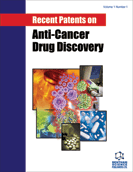
Abstract
In the last decade, the molecular chaperone HSP90 has emerged as an important target in cancer therapeutics and has subsequently become the focus of several drug discovery and development efforts. The first-in-class HSP90 inhibitor 17-AAG entered into Phase I clinical trial in 1999. Today 13 HSP90 inhibitors representing multiple drug classes, with different modes of action, are undergoing clinical evaluation. The present review will highlight the involvement of HSP90 in regulating and maintaining the transformed phenotype, provide an overview on current HSP90 inhibitors and further update on the most relevant patents which have recently appeared in the literature.
Keywords: Cancer therapeutics, cell surface, chaperoning, drug discovery, HSP90, signal transduction.
Recent Patents on Anti-Cancer Drug Discovery
Title:HSP90 Inhibitors: Current Development and Potential in Cancer Therapy
Volume: 9 Issue: 1
Author(s): Katerina Sidera and Evangelia Patsavoudi
Affiliation:
Keywords: Cancer therapeutics, cell surface, chaperoning, drug discovery, HSP90, signal transduction.
Abstract: In the last decade, the molecular chaperone HSP90 has emerged as an important target in cancer therapeutics and has subsequently become the focus of several drug discovery and development efforts. The first-in-class HSP90 inhibitor 17-AAG entered into Phase I clinical trial in 1999. Today 13 HSP90 inhibitors representing multiple drug classes, with different modes of action, are undergoing clinical evaluation. The present review will highlight the involvement of HSP90 in regulating and maintaining the transformed phenotype, provide an overview on current HSP90 inhibitors and further update on the most relevant patents which have recently appeared in the literature.
Export Options
About this article
Cite this article as:
Sidera Katerina and Patsavoudi Evangelia, HSP90 Inhibitors: Current Development and Potential in Cancer Therapy, Recent Patents on Anti-Cancer Drug Discovery 2014; 9 (1) . https://dx.doi.org/10.2174/15748928113089990031
| DOI https://dx.doi.org/10.2174/15748928113089990031 |
Print ISSN 1574-8928 |
| Publisher Name Bentham Science Publisher |
Online ISSN 2212-3970 |
 613
613
- Author Guidelines
- Graphical Abstracts
- Fabricating and Stating False Information
- Research Misconduct
- Post Publication Discussions and Corrections
- Publishing Ethics and Rectitude
- Increase Visibility of Your Article
- Archiving Policies
- Peer Review Workflow
- Order Your Article Before Print
- Promote Your Article
- Manuscript Transfer Facility
- Editorial Policies
- Allegations from Whistleblowers
Related Articles
-
MicroRNA-21 as a Novel Therapeutic Target
Current Cancer Therapy Reviews Advances in Cancer Stem Cell Therapy: Targets and Treatments
Recent Patents on Regenerative Medicine In Vitro Antitumoral Activity of Palladium(II) and Platinum(II) Complexes with O,O'-Dialkyl Esters of Ethylene-bis(S)-Leucine
Letters in Drug Design & Discovery New Directions in Targeting Protein Kinases: Focusing Upon True Allosteric and Bivalent Inhibitors
Current Pharmaceutical Design Genomic Signatures for Individualized Treatment of Malignant Tumors
Current Drug Discovery Technologies Targeted Therapy Towards Cancer-A Perspective
Anti-Cancer Agents in Medicinal Chemistry Effects of Anticancer Drugs in Reproductive Parameters of Juvenile Male Animals and Role of Protective Agents
Anti-Cancer Agents in Medicinal Chemistry MicroRNAs as Early Biomarkers in Obesity and Related Metabolic and Cardiovascular Diseases
Current Pharmaceutical Design Microbubbles: Revolutionizing Biomedical Applications with Tailored Therapeutic Precision
Current Pharmaceutical Design Bioinorganic Chemistry: The Study of the Fate of Platinum-Based Antitumour Drugs
Current Chemical Biology Molecular Mechanisms Responsible for <i>In Vitro</i> Cytotoxic Attributes of <i>Conyza bonariensis</i> Extract against Lymphoblastic Leukaemia Jurkat Cells
Anti-Cancer Agents in Medicinal Chemistry Vinorelbine in the Treatment of Non-Small Cell Lung Cancer
Current Medicinal Chemistry Imatinib and Its Successors – How Modern Chemistry has Changed Drug Development
Current Pharmaceutical Design White Poplar (Populus alba L.) Suspension Cultures as a Model System to Study Apoptosis Induced by Alfalfa Saponins
Anti-Cancer Agents in Medicinal Chemistry Role of Active Drug Transporters in Refractory Multiple Myeloma
Current Topics in Medicinal Chemistry Bacterial Toxins: Potential Weapons Against HIV Infection
Current Pharmaceutical Design Steroidal Conjugates and Their Pharmacological Applications
Current Medicinal Chemistry Flavonoids as Anticancer Agents: Recent Progress and State of the Art?
Current Organic Chemistry Biomarkers and Multiple Drug Resistance in Breast Cancer
Current Cancer Drug Targets Cytotoxic and Antitumoral Activity of N-(9H-purin-6-yl) Benzamide Derivatives and Related Water-soluble Prodrugs
Current Molecular Pharmacology
























